Playing Ghost. An interview with NFTS graduate Bianca Ansems
You may not have heard of newcomer Bianca Ansems yet, but with her film ‘Playing Ghost’ currently causing quite a stir in the animation festival circuit, this looks set to change…
Bianca began with a degree in Animation at the Dutch art college, AKV|St.Joost. Her film, ‘The Somewhat Queer Yet Silly Mr Tophat’, made during her time here, got selected for numerous festivals and toured internationally with TENT Academy Awards – a prestigious award that nominates only one film per Dutch Art College.
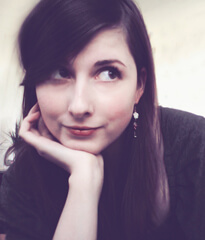
Bianca Ansems
Following this, Bianca then moved to England to pursue an MA in Animation Direction from the National Film and Television School; a highly renowned course, with notable alumni including Nick Park, Mark Baker (Astley Baker Davies) and Tony Collingwood (Collingwood O’hare). For her graduation film, Bianca decided to venture into puppet animation, something she had relatively little experience with. However, upon watching ‘Playing Ghost’, this seems hard to believe, as she is able to convey remarkable depth and the subtle complexities of human emotion effortlessly. Since its release, ‘Playing Ghost’ has received numerous awards including: the Grand Jury Prize at the Student Film Festival Hollywood, 2011, Best Graduation Film at Cinanima, 2011, Best Animation Direction at Animated Exeter, 2012 and Best Animation at the Student Film Festival London, 2012.
Whilst studying, Bianca has also managed to work with several distinguished animation studios. She completed an internship at Trickstudio Lutterbeck in Cologne, Germany, where she specialised in both traditional and digital 2D animation, as well as a work experience placement at Aardman Animations, where she now continues to work freelance.
We caught up with Bianca to discuss how the British animation industry differs from the Dutch, working at Aardman and of course, the process of creating ‘Playing Ghost’.
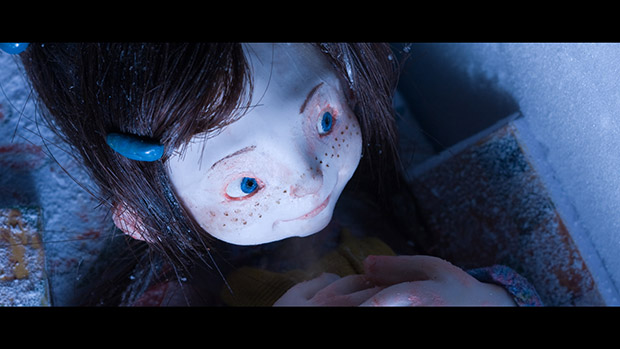
Bianca, thank you for talking to Skwigly. Firstly, what inspired you to become an animator?
I can’t specify a point in time that I decided that this was gonna be it. As I’m sure for most animators the Disney films which were prominent during my childhood in the 80s and 90s were a huge influence. I remember filling in a school form when I was 8 on what we wanted to become when older, and though my previous ambitions ranged from princess to vet, I filled in ‘animator’. “To be in the end credits of Disney.” I didn’t know exactly what it was but I wanted to be part of it.
Unfortunately though I wasn’t one of the cool kids animating their dinosaurs or lego for fun. It wasn’t until I had to decide where to go after secondary school that animation surfaced again (still not knowing what exactly it entailed!). I nearly went into the army, but faith dropkicked me into art school and I just knew I couldn’t be anything else but an animator from then on.You moved from Holland to study for an MA in Directing for Animation at National Film and Television School.
What did you gain from your time studying at NFTS and why did you decide to stay in England after you had completed the course?
The NFTS was an amazing experience. It’s an absolute rollercoaster ride – the Oblivion fades into nothingness compared to have fast you learn things there. After my BA at the Dutch art school AKV|St.Joost – which I very much enjoyed – I felt a bit lost. I wasn’t done yet, and barely after all those years sort of got a grasp on what animation was. I was technically skilled enough, but creatively still felt I needed to break open. This is when NFTS stepped in. Somehow it just pushes you several nudges up both technically and creatively. During my first year, one of the assignments forced me into a different storytelling format from what I was used to and that’s when I discovered that technique wasn’t my signature, but the style of storytelling. It also opened my eyes in how the industry works and how amazing it is to collaborate with other hard-working, extremely talented filmmakers. I sort of already knew when I left the Netherlands that I was probably going to stay in the UK. Or at least go from there to another country.
Do you feel Britain offers more opportunities for emerging animators than Holland?
It depends on what kind of animator you want to become. The Netherlands offered and still does a healthy amount of support and opportunities to make your own film and collaborate with interesting artists and designers. They are also currently producing two feature animation films, which is amazing!
However if you want to become a high-standard professional animator (freelance or for a studio), I feel that there are more opportunities in the UK at the moment. In the UK, particularly in London, we are at one of the main centres of world cinema – and you notice this. Even if you are not fully in it, you are continuously surrounded by people who work at the highest standard and it makes you feel like you still have so much to go for. Big goals just seem more achievable in the UK.
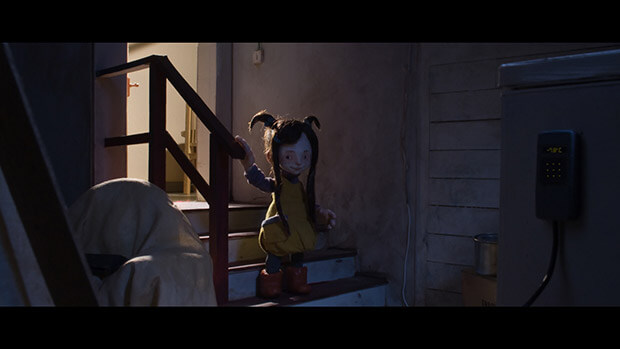
I want to talk to you about your latest film Playing Ghost which is receiving quite a bit of recognition at the moment, winning the Animated Short Film Award at the Student Film Festival. It is a beautiful and heartbreaking story of a daughter coming to terms with the death of her father. Where did this story originate from?
Someone told me about an actress who lost her father at the age of four and started playing funeral with her dolls. It is understood that young children don’t always grasp death to its full extent, but as my mind wandered I was wondering whether her mother would have caught on to what was happening. And then I thought, probably not, she is already in such pain that you just get into a bubble where everything becomes automatism. And I could sympathise with both, as neither one or the other is bad response – it’s just a consequence of the situation.
Overall, I didn’t want to make just another happy, fast-paced, super child-friendly animation. I wanted to tell a gentle, emotional story – and chose to do it through puppets. People sometimes ask me why I didn’t do it with real actors. Of course, there is nothing in the film that couldn’t be done with real actors, but thanks to the puppets you wave over boundaries that would normally be held up – as well as still connect on the normal level. If I would have chucked a real child actor into a freezer, it raises so many alarm bells, that it becomes a horror film. But somehow with Amy, the puppet, you just kind of accept it. Though subconsciously it is still not a good thing to do of course! It was these dual emotions that I needed to tell the story I wanted. Nothing is just black and white.
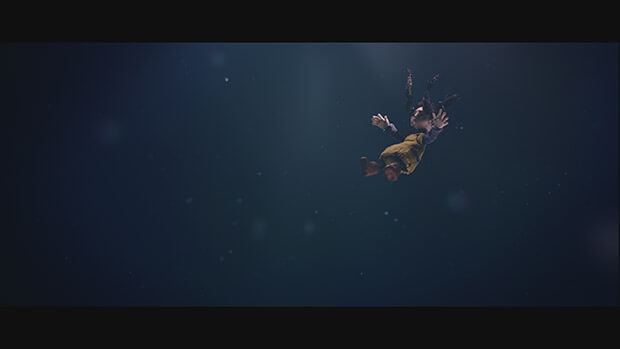
The film has a very distinctive artistic style, as seen in the set, the props as well as the modelling of the characters, what influenced this aesthetic and how has it adapted over the course of the production?
When my scriptwriter Catriona MacLean and me developed the story, I didn’t want to think yet on how it was going to look. Or whether it was going to be an animation at all! This left the storytelling more free and we focused on the feeling and atmosphere rather than practical limitations.
I do know however that I’m a great perfectionist, and just love rich details. The story is very tender so we had to be subtle with everything. Which meant that you could not just blatantly go “OH BTW THE DAD IS DEAD”. We had to hint it all through mood, details in the set, subtle animated emotions, sound, music etc. Then when you add all those bits together they form a picture which most people – because we are humans – can pick up on.
I worked with an amazing team that was able to capture my directions and translate them into what became Playing Ghost. For example, it wasn’t until after the grade that I discovered that the mother is mainly surrounded by magenta, Amy the girl by yellow and the dad is always signalled with blue. One time, someone pointed out during a Q&A that there are parallels between the coldness of the freezer and water and death, contrasted by the warmth of the hob and iron and life. All those choices were there subconsciously but all we really tried to do was tell the story in which way FELT right.
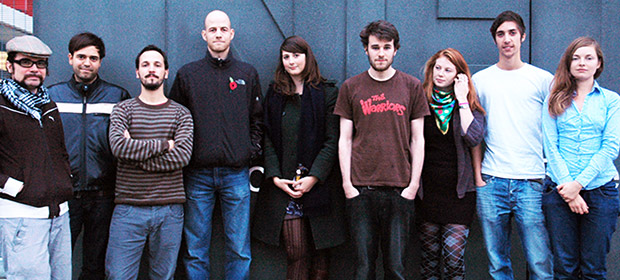
A Large part of the production team (From left to right): Eduardo Serrano editor, Leo Ferreira DPP, Mauricio D’Orey sound editor and mixer, Andrew Start producer, me director, Sam Turner animator, Toni Lowe production designer, Lennert Busch composer, Maja Zamojda cinematographer.
Through sensitive character acting you display the playfulness of the young child together with the fragility of the mother, in a way that appears authentic and well observed. How did you prepare yourself for animating these roles realistically?
Of course part of it I based on own experiences. The hollowness left after a loved one is gone. How you just can’t stop crying yourself to sleep at night, while still having to function during the day. And when I was 5 I fell myself into a pond while playing ghost. Though I remember my initial panic I also remember the calmth that creeps over at some point. Based on those experiences of myself and others we edited the initial animatic.
Then when it came to animating I worked with 2 very talented animators. One is Mike Hollenbeck, who now works on ParaNorman at Laika Studios, and one is Sam Turner, who animates on Postman Pat and animated on Rupert the Bear. As animators are just basically actors, I would tell them what we were trying to convey and they would fill in the gaps. In the end I found that Mike was great with energetic Amy, Sam nailed sensitive Amy (and the underwater scene), and I did emo Mum best… what does that say about me? hahah!
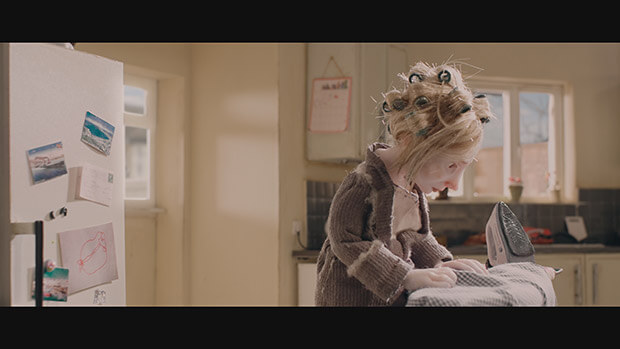
What did you find were the biggest challenges you faced making the film?
One of the biggest challenges was making the film within the budget and time we had without compromising on the story. I guess they sometimes say ‘kill your darlings’ and I tried to stand by that during the production. Many shots and options just had to go because we couldn’t manage it otherwise. Sometimes it was quite difficult to make to decisions, but in the end noone is going to care how long it took you or how tough it was. All the see is the results. And it either works, or it doesn’t. Of course we also had the usual challenges like a puppet breaking down halfway through (Amy got so dirty she needed a redress after 2 months of animating), not knowing how the hell to make paper-mache look like icy mountains (it took a full week of light setup), and the usual ‘stopmotion gremlins’… You know, the ones that expend the set significantly over night (because it cooled down when the lights were out, particularly during the winter), or the ones that drop your massive poly in the set halfway through the shot. But thanks to the hard-working team that really pulled together, including my producer team Andy Start and Adam Jackson, nothing couldn’t be overcome. It’s not perfect in the end, but I think we gave it a good shot.
Playing Ghost was your first stop motion short, why did you chose this form of animation instead of others?
Well, as I said before with the story it just felt right. We needed a full atmospheric image and so I just had to adapt.
I think I also realised that for the grad film at the NFTS as a director you have someone of every department working with you. I thought if any time to do stopmo, it was now. It just made sense.
Do you think you will continue to work within this form of animation?
Initially it was a bit getting used to. I had to accept that stopmo just can’t be a 100% perfect like 2D, but then that’s also exactly it’s charm. Throughout the shooting I started to really enjoy the practical challenges you had to figure out to make a shot work. This meant for example that to create the underwater ripples on the puppets, Maja Zamojda, the cinematographer, suggested after long thinking to use a wheel full with filters that we could turn inch by inch. In the end, it was easiest to just mount a whole bicycle up on a stand. Absolute madness, yet in the shot it looks normal.I really love 2D but I kind of feel too comfortable in it. Everytime I have to do stopmotion it is just a whole new world. “Right so you want a walking robot made of matchboxes…. Yes it’s do-able.. but I just have to figure out how…”
Could you tell us about any other films you have made?
After my graduation I made the trailer for the London International Animation Film Festival. I used a style I had tried before with my Barry Purves exercise ‘Airmail’ which used puppets made of card and fabric. And I tapped into my main inspiration: The Deep Sea (yes with capitals!). I am really quite pleased with the atmosphere that it has, though I wished I had a bit more time to make more creatures!
My last 2D animation I did for myself was ‘At the Busstop’. It was going to be full-color, but in the end as it was a school assignment I couldn’t finish the colouring, tho I’m quite happy with the look as it is at the moment too. I enjoy drawing more extreme proportioned humans!And I guess I should also mention my BA grad film ‘The Somewhat Queer yet Silly Mr.Tophat’. ‘Queer’ (strange) was one of my favorite English words in secondary school, though my English books never told me it more commonly means ‘gay’! So now I’m a bit embarrassed by the title… Story wise it is very faulty, but I can still appreciate the technique. It was also the first film I did together with a small team. That’s when I discovered I really enjoyed directing, as it brings the talents of all these great artists together to make a little film.
You interned at Aardman Animations, what did that involve and what did you gain from the experience?
I gained so much from the internship at Aardman. It was only 2 weeks, but it was absolute bliss (the 2009 heathwave in Bristol helped as well!). I worked in the Timmy Time team, which is smaller than Shaun the Sheep but very very lovely and just right. At first they asked me to crack open some designs for the Timmy Time website. One of the designs I did was the basis for the current Timmy Time website (www.timmytime.tv)! I also worked in the puppet maintenance and prop departments and did digital stills correction.
Working there opened my eyes in terms of working with a large, well-oiled team – all the people together create these wonderful worlds. They treated me all so well! I am dead jealous of anyone working at Aardman as it’s just a wonderful place with a great atmosphere.
Even though I didn’t consider stopmo when I went to intern at Aardman, I do think the good experience had a significant influence in giving me a nudge in the stopmo direction.
Who or what are your major influences?
This is a hard question. I think I’m spoiled for inspiration because everywhere I look there is so much to be in awe of. Of course both the old animation masters and new bold artists have their influence, but I think first and foremost I’m fascinated by human nature, and how unique everyone is. I studied ethical philosophy for a while and was about to do a masters in Humanistics. I’m intrigued that every one of us has different experiences and influences that make us behave or take choices differently. Sometimes this is not the most logical thing to do to an outsider but these factors and their consequences make interesting character stories. In a film – whether it’s a short or a feature – you never have a lot of time to explain all of this background but you can sip through hints. The way a character walks, talks or even picks up a glass suggests a lot. Thinking about this and then translating that into animated frames per second is what I thrive on.
As for atmosphere I love mystical atmospheres. There is a documentary called ‘The Deep’ from the BBC Blue Planet series that I just can’t get enough of. If you ever meet me, just mention the deep sea and I’m off for hours of talking with lots of hand gestures and bright eyes. This documentary in particular does everything right. The pace, the narration, the colours, the sound and music.It seems that somehow in general, water plays a significant role in my films…
Could you tell us what future projects you have got lined up?
I am currently working on short animations for one of the gardens of the Royal Horticultural Society (RHS). They are little animations explaining kids about root vegetables in one of their permanent exhibitions. I really enjoy doing little animations that explain “scientific” material!
I’m also about to embark on a private commission for a new stop-motion short which I can’t really give too much details about! But it’s a fun story which will keep me entertained for the next few months. I can’t wait to get back to puppet animation!Other than that I got selected for the Animation Exchange Forum at the Dresden Short Film Festival (17th – 22nd april), which will allow me to meet and potentially collaborate with other fantastic filmmakers, and develop new ideas for my own future animations.
So busy times!
—-
Here’s a production time lapse:

